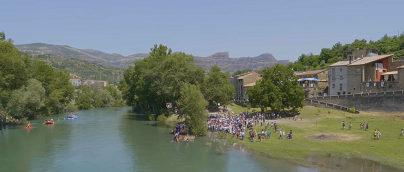
If you prefer to always view the website in English, please click here.
If you prefer to always view the website in English, please click here.
In 2000, the appearance of TSE (Transmissible Spongiform Encephalopathy), commonly known as “mad cow disease” had a significant impact on the environment and species conservation. The regulations imposed because of this health alert required animal carcasses to be removed from all farms, which led to a food crisis among necrophagous bird species, thus resulting in reduced populations.
At Endesa, as part of our Biodiversity Conservation Plan, we identified the need to promote and support assisted food initiatives to help re-establish this balance that had been lost for many necrophagous species and large birds of prey native to the Pyrenees. Since 2011, we have been promoting the project for the creation of Supplementary Food Points (PAS for its Spanish acronym), in the Pyrenees, in collaboration with the TRENCA association and, more recently, also with the Naturaleza Rural association. This initiative provides support for their programme designed to reintroduce the cinerous vulture into the area, a species that had disappeared from this region.
These specific initiatives form part of our continuous efforts to adapt power lines in order to protect these species. Together with these projects, at Endesa, we have carried out extensive work to insulate the power lines used as perches by these birds, installing reflective beacons and any necessary improvements, with the aim of preventing incidents and contributing to the conservation of the species.
Through our collaboration , three PAS have been installed in the Lleida Pyrenees area and assistance has been given to another two in the Huesca Pyrenees area, which have made it possible to meet the needs that carrion-feeding birds could not obtain naturally, besides making food available for them in a sanitary controlled manner.
“The installation of PAS is vital for the reintroduction of species that have disappeared, such as the cinereous vulture, the Egyptian vulture, the bearded vulture and other large birds of prey. Thanks to these, their food is guaranteed as well as improving their reproductive success.”
Jesús Almarza, Technician at TRENCA.
Necrophagous birds and their balanced presence are essential in order to eliminate infection points in our countryside and their disappearance would destabilise the natural balance of our ecosystems. The cinereous vulture, the bearded vulture and the Egyptian vulture and other large birds of prey are all protected species and the main beneficiaries of the PAS today. As their food is guaranteed, the reproductive success of the species increases and therefore, the chances of survival of these protected species increases too.
Endesa’s assisted food points programme provides support for the project aimed at reintroducing the cinereous vulture in the Pyrenees, developed by TRENCA. It began in 2007, as a result of the need to recover this reproductive species that disappeared in the latter half of the 19th century. The aim is for this new population to strengthen the bond with the French population, thus increasing the genetic variation.
The most recent results of the project demonstrate its success through the presence of black vultures in all the PAS. Although it also highlights the appearance of the griffon vulture with a large presence of individuals between 90 and 200 specimens and other species such as the Egyptian vulture, the Bearded Vulture or the Royal Kite with up to 9 individuals. As a feeding point, they have even attracted the Black Kite with up to 12 individuals, the Golden Eagle, the Buzzard with up to 4 individuals and the Raven with a presence of 30-50 individuals.
The project makes it possible to monitor target species with direct observations and through photo-trapping. In the more than twelve years that it has been up and running, it has been possible to develop a large and stable colony of black vultures (close to 200 individuals). A large part of this success is thanks to the PAS, which have become a key factor for feeding this species. They often use them, particularly during the most important breeding times, which contributes to the reproductive success of the species.
Farmers and breeders in the area provide the land for the PAS and contribute towards the provision of the carrion by providing, for example, animals that have died on their farms. These meat products not destined for human consumption are fed to the birds together with those from local abattoirs.
The technicians from TRENCA and Rural Nature, together with Endesa, coordinate the entire process, monitoring the species and arranging the bird feeder maintenance and cleaning tasks.
The technique for providing food has improved over the years. Currently focus on small and somewhat hidden pieces, which is what the cinereous vulture, the bearded vulture and the Egyptian vulture prefer. This ensures that it is not eaten by other carrion species that do not have population problems in the area, such as the griffon vulture, which eats large pieces in a group.
The project for the implementation of Supplementary Food Points for necrophagous birds in the Pyrenees is related to environmental education. Throughout 2019, it has been disseminated in the schools and colleges in the area through workshops and teaching sessions. Furthermore, each year, visits are arranged for those interested in the project in order to learn more about necrophagous birds.
This project has become significantly relevant and has been published in important scientific magazines like the 'Journal of Applied Ecology' and 'Nature'.
The future aim is for these birds not to need the PAS for food and to be able to develop naturally. The PAS will continue to provide significant support for managing cattle or other dead animals, which is beneficial both environmentally and economically.





